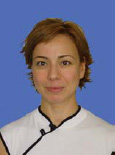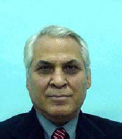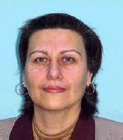|
|
|
| |
| ABSTRACT |
|
The effects of aerobic exercise training on skeletal muscle endurance capacity were examined in diabetic rats in situ. Moderate diabetes was induced by iv injection of streptozotocin and an exercise training program on a treadmill was carried out for 8 weeks. The animals randomly assigned to one of the four experimental groups: control-sedentary (CS), control-exercise (CE), diabetic-sedentary (DS) or diabetic-exercise (DE). The changes in the muscle endurance capacity were evaluated through the square wave impulses (supramaximal) of 0.2-ms duration at 1 Hz in the in situ gastrocnemius-soleus muscle complex. Muscle was stimulated continuously until tension development reduced to the half of this maximal value. Time interval between the beginning and the end of stimulation period is defined as contraction duration. Following the training period, blood glucose level reduced significantly in the DE group compared to DS group (p < 0.05). The soles muscle citrate synthase activity was increased significantly in both of the trained groups compared to sedentary animals (p < 0.05). Fatigued muscle lactate values were not significantly different from each other. Ultrastractural abnormality of the skeletal muscle in DS group disappeared with training. Presence of increased lipid droplets, mitochondria clusters and glycogen accumulation was observed in the skeletal muscle of DE group. The contraction duration was longer in the DE group than others (p < 0.001). Fatigue resistance of exercised diabetic animals may be explained by increased intramyocellular lipid droplets, high blood glucose level and muscle citrate synthase activity. |
| Key words:
Training, citrate synthase, muscle endurance, ultrastructure, diabetes
|
Key
Points
- Aerobic training of diabetic animals increased the endurance capacity.
- Presence of abnormal ultrastructural alterations with diabetes disaapered with regular training.
- Increased intramyocelluler lipid droplets, high blood glucose level with citrate synthase activity may explain this finding.
|
Diabetes mellitus (DM), is a catabolic disease which mainly affects the skeletal muscle, adipose tissue and liver by bringing about impairments in carbohydrate and lipid metabolism. Fat and carbohydrate are the principal substrates that fuel aerobic ATP synthesis in skeletal muscle (Van Loon, 2004). Elevated plasma concentration of those substrates in DM causes serious damages in ultrastructure and metabolism of the skeletal muscle together with other tissues. Reduction of muscle weight with abnormal arrangement of myofibrils, mitochondrial swelling and lysis of mitochondrial cristae at spontaneous diabetic rats are reported previously as the ultrastructural abnormalities (Ozaki et al., 2001). Metabolic changes classified as altered ratio between glycolytic and oxidative enzyme activities of skeletal muscle that suggests the irregularity between mitochondrial oxidative capacity and capacity of glycolysis (Simoneau and Kelley, 1997). On the other hand there has been a long standing interest with the relationship between muscle lipid content and skeletal muscle insulin resistance. Various studies have reported a strong association between intramyocellular lipid accumulation, and development of DM (Jacob et al., 1999; Koyama et al., 1997; Oakes et al., 1997; Perseghin et al., 2002). Adaptability to exercise is an enormous property of the skeletal muscle. The high capacity to modulate energy production rate, blood flow and substrate utilization indicate the metabolic flexibility of this tissue (Saltin and Gollnick, 1983). Due to attenuating effect on skeletal muscle catabolism, aerobic exercise training is frequently suggested for prevention and treatment of DM. Response to aerobic exercise is compromised with an adaptive increase in insulin responsiveness and sensitivity (Mikines et al., 1989; Nesher et al., 1985) and enhanced glucose uptake (Hayashi et al., 1997; Rodnick et al., 1992) in skeletal muscle. Previous studies had shown that increased GLUT4 protein is a component of the adaptive response of muscle to endurance training and associated with increased capacity for glucose transport into the skeletal muscle (Rodnick et al., 1992). Exercise can also increase glucose uptake in skeletal muscle by increasing both insulin activity (Nesher et al., 1985; Mikines et al., 1989) and membrane GLUT4 exposition (Goodyear et al., 1992; Reynolds et al., 1997). Nobre and Ianuzzo (1985) had shown that enzymatic potential of all skeletal muscle types of diabetic rats may be normalized by exercise training even in the absence of significant amounts of insulin. In addition to that, the importance of muscle contraction and insulin for fatty acid transporter (FAT-CD36) translocation from an intracellular depot to the plasma membrane had been shown previously (Dyck and Bonen, 1998; Dyck et al., 2000; 2001; Bonen et al., 2000; Luiken et al., 2002). As a result of these consecutive changes, regular aerobic training may enhance the endurance of muscle by increasing the availability of energy substrates for skeletal muscle contraction together with oxidation of glucose and fatty acids (Bonen et al., 1999). Changes in the enzymatic activity as well as the membrane transport protein content may explain the beneficial effect of regular training in DM. On the other hand, there is an uncertainty about the effect of regular exercise on skeletal muscle endurance capacity in diabetic animals. Although endogenous fat stores correspond to a tremendous energy store and especially in trained subjects, utilization of intramyocellular triacylglycerol may account for considerable portion of energy requirement (Van Loon, 2004) during aerobic exercise. Therefore, in terms of endurance capacity, elevated plasma glucose level together with increased intramyocellular triacylglycerol may be an advantage for diabetic animals compared to controls. With this in mind, we aimed to investigate detailed effects of regular exercise on the endurance capacity of the isolated skeletal muscle in situ. Animals and housingWistar strain albino male rats weighing 150-300 g were used in this study. The animals randomly assigned to one of the four experimental groups: control-sedentary (CS; n = 22), control-exercise (CE; n = 22), diabetic-sedentary (DS; n = 14) or diabetic-exercise (DE; n = 21). The rats were housed four per cage in a temperature-controlled animal room maintained on a 12:12 h light-dark cycle. All experimental protocols were approved by the University of Cukurova Committee for the Use and Care of Animals.
Inducing diabetesExperimental diabetes was produced by a single intravenous injection of streptozotocin (STZ) (Sigma, S-0130) with a dose of 45 mg·kg-1. Before the injection, STZ was freshly prepared in a 0.10 M citrate buffer solution. The diabetic state was verified by evaluating the urine glucose existence via urine stick (Glukotest-No:184047) 48 - 72 h later than the STZ injection. The animals in the control group had the same amount of 0.1 M citrate buffer injections. In order that the activities of the selected enzymes might achieve new steady-state levels after induction of diabetic condition (Armstrong and Ianuzzo, 1976), exercise training initiated at the end of fourth week of STZ injection.
Exercise protocolFollowing the stabilization period, the animals in the exercise groups were performed aerobic exercise on a treadmill during a period of eight weeks. Before the training, the rats were adapted to the training environment by placing them inside the treadmill during 30 min, twice a day for two days. The exercise was performed in an 8° inclined treadmill twice a day during five days a week. The exercise protocol was arranged as follows: in the first two weeks animals were run with a speed of 12 m·min-1 for 10 min, in the following 3 weeks running speed was adjusted to 22-23 m·min-1 for 40 min and in the last 3 weeks, speed was set to 23-25 m·min-1 for one hour. The animals were made to run during the same hours of the day and approximately 4 h of resting time was given to animals between training sessions. The related studies have shown that the exercise at this intensity is suitable for approximately 75% constraining in the capacity of rats (Brooks and White, 1978; Lawler et al., 1993). The animals in the sedentary groups were kept in their cages until the final day.
Blood glucose levels measurementsThe blood glucose levels of control and exercise group animals were measured by using the tail blood samples taken at the end of four weeks stabilization period and before the final experiment on which the muscle performance was evaluated. The plasma glucose levels were determined by means of an enzymatic colorimetric method (Isotec 7130 Glucose).
Evaluation of the contraction durationThe animals were taken to the surgery for muscle endurance evaluation 24 hours after the last exercise session. Animals were anesthetized with intraperitoneal 50-75 mg·kg-1 pentobarbital sodium injection. Their left gastrocnemius-soleus muscle complex (for convenience referred to as gastrocnemius) isolated in a similar way as described previously (Hogan and Welch, 1986). Rats were intubated and ventilation was maintained with Harvard Rodent Ventilator (Model 683). Maintenance doses of pentobarbital sodium were given as required. Carotid artery was catheterized to monitor systemic arterial blood pressure (Grass, PT 300) and recorded (Grass Polygraph, Model 7) throughout the experiment. In addition, the jugular vein was catheterized, connected to infusion pump (KD Scientific) and isotonic NaCl was infused in an amount of 1ml/h in order to prevent the insensible fluid loss.
Surgical preparationThe contraction duration of the muscle were also evaluated through the in situ preparation of gastrocnemius muscle group (Hogan et al., 1995; Fitts and Holloszy, 1977). Briefly, a medial incision was made through the skin of the left hindlimb from midthigh to the ankle. Muscles which overlie the gastrocnemius were doubly ligated and cut between the ties. Arterial circulation to the gastrocnemius and vessels draining from this muscle complex were isolated. Left sciatic nerve, which innervates the gastrocnemius, was doubly ligated and cut between ties. To prevent cooling and drying, all exposed tissues were covered with saline-soaked gauze. Following the surgical preparation, Achilles tendon was attached to an isometric myograph (Grass Grass FT03 E transducer) and muscle tension development was recorded (Grass Polygraph, Model 7). The hindlimb was fixed to minimize movement and left for 20 minutes to rest. Before contraction period, optimal muscle length was adjusted to the length at which the contractile response was greatest by checking the tension development with single stimulus. Weights were used at the end of each experiment to calibrate the tension myograph.
Experimental protocolIsometric muscle contractions (twitch) were elicited by stimulating directly the muscle with square wave impulses (supramaxsimal) of 0.2-ms duration at 1 Hz with needle electrodes. This relatively low work intensity was chosen to minimize potential causative agents of fatigue (Hogan et al., 1988). Since we aimed to evaluate the effect of training in aerobic metabolism and muscle endurance, this low frequency exercise protocol was especially performed (Dyck and Bonen, 1998). Maximal tension development that the muscle reached at the beginning of stimulation protocol was accepted as 100%, and stimulated continuously until tension development reduced to the half of this maximal value (fatigue). Time interval between the beginning and the end of stimulation period is defined as contraction duration. Blood pressure and tension development were recorded simultaneously through the contraction period to eliminate any negative effect of irregular perfusion on muscle tension development.
Biochemical procedureImmediately after the contraction period, soleus and gastrocnemius muscles were excised, frozen in liquid N2 and kept at -70° C (Lozone, CFC Free Freezer) for later analysis of intracellular lactate concentrations. The similar process mentioned above was employed to the contralateral uncontracted muscle complex for citrate synthase activity measurements. Muscle citrate synthase activity analysis was carried out according to the classical method of Srére (1969). Since more oxidative fibers may adapt to increased exogenous carbohydrate use (Noble and Ianuzzo, 1985), soleus muscle samples were used to measure above mentioned enzyme activities. For the measurements of gastrocnemius muscle lactate concentration, muscle samples were homogenized up to the methodology explained in details by Luis et al. (2001). Measurements were performed by using Sigma Lactate Kit (Sigma 735-10) and Sigma Standard Lactate Solution (Sigma 826 -10).
Preparation of the muscle tissues for electron microscopic observationFive rats from each group were anesthetized with pentobarbital sodium (75 mg·kg-1) and a catheter was inserted into carotid artery. The abdominal vein was cut to exsanguinate animals. In the following step, all the tissues were fixed by paraformaldehyde perfusion via carotid artery for one hour. Then, the samples taken from the gastrocnemius- soleus muscles were fixed for four hours with 5% gluteraldehyde solution that was prepared with Millonig buffer. The next fixation of the tissue pieces were performed for two hours with 1% osmium tetroxide solution that was prepared with Millonig buffer. After the fixation procedure, the tissues were dehydrated with the increasing concentrations of ethyl alcohol and embedded into araldyde. The slices that were taken from the blocks were observed with Zeiss E M 10B electron microscope.
Statistical analysisData are presented as means (± SEM). An ANOVA was performed to determine differences within each group. Following a significant ANOVA F ratio, we performed Duncan test to locate significant difference. Differences are accepted as significant at P < 0.05 level.
The effect of streptozotocin on the blood glucose levelBlood glucose level was significantly increased in diabetic animals at 4th week of STZ injection (p < 0.001) and the difference was then maintained until the final week of training (p < 0.001). However, following the 8 weeks of training period, the blood glucose level of exercised diabetic animals were reduced significantly compare to the sedentary diabetic animals (p < 0.05) (Table 1).
The electron microscopy findingsIn the micrographs of the gastrocnemius (Figure 4) muscle of CS group, no abnormal structural changes were observed in organelles and sarcomere arrangements of the skeletal muscle. Histologically, myofibrils of the muscle fibers of the CE group had normal sarcomere arrangement. Different sized mitochondria and elegant glycogen particles were observed in the miyofibrillar structure (Figure 5). The main histopathological changes of DS rats gastrocnemius muscle was an abnormal arrangement of myofibers (Figure 6A). Soleus muscle micrographs of this group had shown the preserved sarcolemmal structure together with lipid droplets (Figure 6B). Abnormal structural view of the gastrocnemius muscle at DS group disappeared in exercise (Figure 7A). Soleus muscle micrographs of DE groups had shown the presence of normal miyofiber structure together with increased lipid droplet content, glycogen accumulation and mitochondrial clusters beside cell nuclei (Figure 7B).
The main finding of this study was the increased endurance capacity of the skeletal muscle in aerobically trained diabetic animals in agreement with Gul et al. ‘s results (Gul et al., 2003). Ultrastructural and metabolic alterations in skeletal muscle of exercised diabetic rats may explain to this result. Training protocolThe exercise intensity that we used corresponds to approximately 75% of rats’ maximal metabolic capacity (Brook and White, 1978; Murphy et al., 1981). Accumulated data suggest that this exercise intensity is nearly equal to lactate threshold and therefore this training protocol defined as aerobic (Coen et al., 1991; Fohrenbach et al., 1987; Yoshida et al., 1982). The increased muscle citrate synthase activity, which is quantitatively similar to previously reported data (Atalay et al., 2004; Kainulainen et al., 1994; Noble and Ianuzzo, 1985) indicate the efficiency of training protocol on muscle metabolism. The significant reduction of blood glucose level in trained diabetic animals compare to sedentary diabetic rats supports the efficiency as well.
Electron microscopic observationPresence of abnormal ultrastructural alterations in skeletal muscle in terms of miyofiber arrangements, various degrees of degeneration and necrosis in severely STZ-induced diabetes had been shown previously (Klueber and Feczko, 1994). Even though our findings are consistent with these data, abnormalities that we observed are not as obvious as Klueber and Feczko (1994) presented. Moderate diabetes model which we used in the present study may explain this disparity. In previously reported STZ-induced and genetic diabetic models, pathological changes in muscle were considered to be formed by a combination of neurogenic and myogenic factors (Ozaki et al., 2001). Due to the training protocole that we used in our study, animals had to contract their extremity muscles continuously to perform the running activity. Since repeated muscle contractions increase neuromuscular synapse number, this possible alteration in muscle structure may help to recover the neurogenic pathology (Häkkinen, 1994). Reduced blood glucose level with increased citrate synthase enzyme activity may indicate the metabolic alterations due to endurance training. Even the neuromuscular changes had not been evaluated, a possible structural alteration, together with the metabolic changes, may explain the recovery in our myographs. On the other hand, no abnormal finding in CS group muscle samples increases the importance of blood glucose level on foregoing abnormalities in diabetic animals and may eliminate the effect of physical inactivity alone.
Metabolic changesAs reviewed extensively by van Loon (2004), intramyocelluler lipid droplets, which are higher in type I muscle fibers compare to type II fibers, function as a readily available pool of fatty acid for oxidation. As shown by Shrauwen et al. (2002), training status of the skeletal muscle is important to determine the capacity of muscle and/or lipoprotein derived triglyceride utilization as energy substrate. Beside that, insulin resistance disappears with the inclusion of endurance training (Goodpaster et al., 2001; Thamer et al., 2003). In our experiment, low dose of STZ was used to induce moderate diabetes and kept animals alive without insulin injection. Because of this situation, we may assume the presence of certain amount of insulin at the diabetic animals. Insulin and regular exercise are the two important signals of sarcolemmal GLUT 4 transporter exposition. These possible changes in skeletal muscle with the chances in insulin sensitivity may explain the reduced blood glucose level in DE group (Goodpaster et al., 2001; Thamer et al., 2003). There are reports suggesting type I muscle fibers to be more insulin sensitive than type II fibers and contain about threefold more lipid than type II muscle fibers (Henriksen et al., 1990; James et al., 1985; Kern et al., 1990). Beside that Bonen et al. (1999) had shown the increased muscle oxidative capacity together with the increase in the rate of fatty acid transport and fatty acid transporter (FAT/CD36) at the sarcolemmal membrane together with the mitochondrial membrane carnitine palmitoyltransferase I (CPT I) (Tunstall et al., 2002). Elevated level of intramyocelluler lipid content together with training (Dyck et al., 2000) and muscle contraction (Dyck et al., 2001) may increase fatty acid uptake and function as an important substrate source during exercise.
Muscle fatigueThe significantly increased endurance time of the diabetic exercised animals that we measured in the present study is contradictory to the literature (Gül et al., 2003). Physical activities lasting in hours are defined as aerobic and in these types of physical activities both carbohydrate and fat provide energy requirement (Booth and Thomason 1991). The stimulation protocol that we used in our study results less than 30% increase in oxygen uptake, therefore it is possible to accept muscle contractions as aerobic in our study (Hogan et al., 1988). The ATP requirement at these low intensity contraction bouts is provided mostly by intramuscular lipid oxidation (Dyck and Bonen, 1998). Putting all these together, exercised diabetic animals in our study might have had advantage compared to other groups in terms of fatigue resistance. Increased citrate synthase activity with intramyocelluler lipid droplets and possible chances in muscle membrane glucose and FA transporters means an opportunity to reach tremendous amount of substrate during twitch contractions that may explain the significantly higher contraction duration that we observed. On the other hand, the increase in muscle citrate synthase activity that we observed in the CE group did not cause any significant difference in contraction duration. The only difference that we proposed was the absence of mass action effect of the hyperglycemia associated with diabetes and lipid availability as energy substrate. At this point, we do not have any direct evidence to show the changes in substrate availability in details for this study. The intramuscular lactate values of fatigued muscles that we found are in agreement with the data that Ferreira et al (2001) presented. The increased lactic acid concentration has been implicated as one of the probable causative agents of muscle fatigue (Hogan et al., 1984; 1986; Karlsson et al., 1975; Yates et al., 1983). Since intramuscular lactate values of CS, CE, DS, and DE were not significantly different from each other, accumulation of this metabolite may explain the %50 reduction in tension development for each group. Even though it was not significant, interestingly higher lactate concentration in DE groups compared to other groups may indicate the advantage of increased concentration of substrate and enhanced oxidative capacity of the skeletal muscle. These metabolic changes might have compensated the fatigue inducing effect of lactate. In fact these muscles had been able to keep their tension stable and contracted much longer compare to the other groups that investigated in this study.
ConclusionsAerobic training of diabetic animals increased the endurance capacity. Increased intramyocelluler lipid droplet, high blood glucose level with citrate synthase activity may explain this finding. Further investigations are needed to clarify the mechanism of increased endurance capacity in trained diabetic animals.
Metabolic changes and endurance capacityChanges in muscle citrate synthase activity are shown in Figure 1. In both control and diabetic groups, 8 weeks of regular exercise resulted a significant increase in muscle citrate synthase activity (p < 0.05). However, difference between sedentary and endurance trained animals was not significantly different (p > 0.05). The average contraction duration of DE group was significantly different compare to CS, CE, and DS group (p < 0.01) (Figure 2). Gastrocnemius muscle lactate values at the end of contraction period are markedly increased compared to the resting lactate values that published by Ferreira et al (2001). However, concentrations of the fatigue muscles did not differ significantly between the control and diabetic animals (Figure 3).
| ACKNOWLEDGEMENTS |
This study was supported by TUBITAK, Ankara, Turkey, (SBAG – 1887). |
|
| AUTHOR BIOGRAPHY |
|
 |
Nilay Ergen |
| Employment: Physiologist, Haydarpasa Numune Hospital, Istanbul. |
| Degree: MD |
| Research interests: Exercise physiology, obesity and diabetes. |
| E-mail: nilayergen@mynet.com |
| |
 |
Hatice Kurdak |
| Employment: Family Medicine Specialist, Univ. of Cukurova, Medical Faculty, Department of Family Physician, Adana. |
| Degree: MD |
| Research interests: Adolescence medicine. |
| E-mail: hkurdak@cu.edu.tr |
| |
 |
Seref Erdogan |
| Employment: Ass. Prof. Univ. of Cukurova, Medical Faculty, Department of Physiology, Adana. |
| Degree: MD |
| Research interests: Intracellular pH and Calcium measurement. |
| E-mail: serdogan@cu.edu.tr |
| |
 |
Ufuk Ozgü Mete |
| Employment: Prof., Univ. of Cukurova, Medical Faculty, Department of Histology and Embryology, Adana. |
| Degree: PhD |
| Research interests: Ultrastructural tissue analysis. |
| E-mail: umete@cu.edu.tr |
| |
 |
Mehmet Kaya |
| Employment: Prof., Univ. of Cukurova, Medical Faculty, Department of Histology and Embryology, Adana. |
| Degree: PhD |
| Research interests: Testicular ultrastructure. |
| E-mail: mkaya@cu.edu.tr |
| |
 |
Nurten Dikmen |
| Employment: Prof., Univ. of Cukurova, Medical Faculty, Department of Biochemistry, Adana. |
| Degree: PhD |
| Research interests: Biochemical basis of enzyme studies. |
| E-mail: ndikmen@cu.edu.tr |
| |
 |
Ayşe Doğan |
| Employment: Prof., Univ. of Cukurova, Medical Faculty, Department of Physiology, Adana. |
| Degree: PhD |
| Research interests: Hypertension, hemodynamics and blood pressure regulation. |
| E-mail: adogan@cu.edu.tr |
| |
 |
Sanli Sadi Kurdak |
| Employment: Prof., University of Cukurova, Medical Faculty, Department of Physiology, Adana. |
| Degree: MD, PhD |
| Research interests: Exercise physiology. |
| E-mail: sskurdak@cu.edu.tr |
| |
|
| |
| REFERENCES |
 Armstrong R.B., Ianuzzo C.D. (1976) Decay of succinct dehyrogenase activity in rat skeletal muscle following streptozotocin injection. Hormone and Metabolism Research 8, 392-394. |
 Atalay M., Oksala N.K.J., Laaksonen D.E., Khanna S., Nakao C., Lappalainen J., Roy S., Hänninen O., Sen C.K. (2004) Exercise training modulates heat shock protein response in diabetic rats. Journal of Applied Physiology 97, 605-611. |
 Bonen A., Dyck D.J., Ibrahimi A., Abumrad N.A. (1999) Muscle contractile activity increases fatty acid metabolism and transport and FAT/CD36. American Journal of Physiology Endocrinology and Metabolism 276, E642-E649. |
 Bonen A., Luiken J.J.F.P., Arumugam Y., Glatz J.F.C., Tandon N.N. (2000) Acute regulation of Fatty Acid uptake involves the cellular redistribution of fatty acid translocase. The Journal of Biological Chemistry 275, 14501-14508. |
 Booth F.W., Thomason D.B. (1991) Molecular and cellular adaptation of muscle in response to exercise: perspectives of various models. Physiological Reviews 71, 541-485. |
 Brooks G.A., White T.P. (1978) Determination of metabolic and heart rate responses of rats to treadmill exercise. Journal of Applied Physiology: Respiratory, Environmental and Exercise Physiology 45, 1009-1015. |
 Coen B., Schwartz L., Urhausen A., Kindermann W. (1991) Control of training in middle and long distance running by means of the individual anaerobic threshold. International Journal of Sports Medicine 12, 519-524. |
 Dyck D.J., Bonen A. (1998) Muscle contraction increases palmitate esterification and oxidation and triacylglycerol oxidation. American Journal of Physiology Endocrinology and Metabolism 275, E888-E896. |
 Dyck D.J., Miskovic D., Code L., Luiken J.J.F.P., Bonen A. (2000) Endurance training increases FFA oxidation and reduces triacylglycerol utilization in contracting rat soleus. American Journal of Physiology Endocrinology and Metabolism 278, E778-E785. |
 Dyck D.J., Steinberg G., Bonen A. (2001) Insulin increases FA uptake and esterification but reduces lipid utilization in isolated contracting muscle. American Journal of Physiology Endocrinology and Metabolism 281, E600-E607. |
 Ferreira L.D.M.C.B., Bräu L., Nikolovski S., Raja G., Palmer T.N., Fournier P.A. (2001) Effect of streptozotocin-induced diabetes on glycogen resynthesis in fasted rats post-high-intensity exercise. American Journal of Physiology Endocrinology and Metabolism 280, E83-91. |
 Fitts R.H., Holloszy J.O. (1977) Contractile properties of rat soleus muscle: effects of training and fatigue. American Journal of Physiology 233, C86-C91. |
 Fohrenbach R., Mader A., Hollmann W. (1987) Determination of endurance capacity and prediction of exercise intensity for training and competition in sports marathon runner. International Journal of Sports Medicine 8, 11-18. |
 Goodpaster B.H., He J., Watkins S., Kelley D.E. (2001) Skeletal muscle lipid content and insulin resistance: evidence for a paradox in endurance-trained athletes. The Journal of Clinical Endochrinology and Metabolism 86, 5755-5761. |
 Goodyear L.J., Hirsman M.F., Valyou P.M., Horton E.S. (1992) Glucose transporter number, function and subcellular distribution in rat skeletal muscle after exercise training. Diabetes 41, 1091-1099. |
 Gul M, Atalay M., Hänninen O. (2003) Endurance training and gluthathione-dependent anti oxidant defence mechanism in the heart of the diabetic rats. Journal of Sports Science and Medicine 2, 52-61. |
 Gulati A.K., Swamy M.S. (1992) Regeneration of skeletal muscle in streptozotocin-induced diabetic rats. The Anatomical Record 229, 298-304. |
 Hayashi T., Wojtaszewski J.F.P., Goodyear L.J. (1997) Exercise regulation of glucose transport in skeletal muscle. American Journal of Physiology 273, E1039-E1051. |
 Henriksen E.J., Bourey R.E., Rodnick K.J., Koranyi L., Permutt M.A., Holloszy J.O. (1990) Glucose transporter protein content and glucose transport capacity in rat skeletal muscles. American Journal of Physiology Endocrinology and Metabolism 259, E593-E598. |
 Hogan M.C., Gladden L.B., Kurdak S.S., Poole D.C. (1995) Increased (lactate) in working dog muscle reduces tension development independent of pH. Medicine & Science in Sports & Exercise 27, 371-377. |
 Hogan M.C., Roca J., Wagner P.D., West J.B. (1988) Limitation of maximal O2 uptake and performance by acute hypoxia in dog muscle in situ. Journal of Applied Physiology 65, 815-821. |
 Hogan M.C., Welch H.G. (1984) Effect of varied lactate levels on bicycle ergometer performance. Journal of Applied Physiology 57, 507-513. |
 Hogan M.C., Welch H.G. (1986) Effect of altered O2 tension on muscle metabolism in dog skeletal muscle during fatiguing work. American Journal of Physiology Cell Physiology 251, C216-C222. |
 Häkkinen K. (1994) Neuromuscular adaptation during strength training, aging, detraining, and immobilization. Critical Reviews in Physical and Rehabilitation Medicine 6, 161-198. |
 Jacob S., Machann J., Rett K., Brechtel K., Volk A., Renn W., Maerker E., Matthaei S., Schick F., Claussen C.D., Haring H.U. (1999) Association of increased intramyocellular lipid content with insulin resistance in lean nondiabetic offspring of type 2 diabetic subjects. Diabetes 48, 1113-1119. |
 James D.E., Jenkins A.B., Kraegen E.W. (1985) Heterogeneity of insulin action in individual muscles in vivo: euglicemic clamp studies in rats. American Journal of Physiology Endocrinology and Metabolism 248, E567-E574. |
 Kainulainen H., Komulainen J., Joost H.G., Vihko V. (1994) Dissociation of the effects of training on oxidative metabolism, glucose utilization and GLUT4 levels in skeletal muscle of streptozotocin-diabetic rats. Pflugers Archive 427, 444-449. |
 Karlsson J., Bonde-Peterson F., Henricksson J., Knuttgen H.G. (1975) Effects of previous exercise with arms or legs on metabolism and performance in exhaustive exercise. Journal of Applied Physiology 38, 763-767. |
 Kern M., Wells J.A., Stephens J.M., Elton C.W., Freidman J.E., Tapscott E.B., Pekala P.H., Dohm G.L. (1990) Insulin responsiveness in skeletal muscle is determined by glucose transporter (GLUT-4) protein level. The Biochemical Journal 270, 397-400. |
 Klueber K.M., Feczko J.D. (1994) Ultrastructural, histochemical, and morphometric analysis of skeletal muscle in amurine model of type 1 diabetes. The Anatomical Record 239, 18-34. |
 Koyama K., Chen G., Lee Y., Unger R.H. (1997) Tissue triglycerides, insulin resistance, and insulin production: implications for hyperinsulinemia of obesity. American Journal of Physiology Endocrinology and Metabolism 273, E708-E713. |
 Lawler J.M., Powers S.K., Mammeren J., Martin A.D. (1993) Oxygen cost of treadmill running in 24- month-old Fischer -344 rats. Medicine & Science in Sports & Exercise 25, 1259-1264. |
 Luiken J.J.F.P., Dyck D.J., Han X.X., Tandon N.N., Arumugam Y., Glatz J.F.C., Bonen A. (2002) Insulin induces the translocation of the fatty acid transporter FAT/CD36 to the plasma membrane. American Journal of Physiology Endocrinology and Metabolism 282, E491-E495. |
 Luis D.M.C., Ferreiara B., Bräu L., Nikolovski S., Raja G., Palmer T.N., Fournier P.A. (2001) Effect of streptozotocin-induced diabetes on glycogen resynthesis in fasted rats post-high-intensity exercise. American Journal of Physiology Endocrinology and Metabolism 280, E83-91. |
 Mikines K.J., Sonne B., Farrel P.A., Tronier B., Galbo H. (1989) Effect of training on the dose- response relationship for insulin action in men. Journal of Applied Physiology 66, 695-703. |
 Murphy R. D., Vailas A.C., Tipton C.M., Matthes R. D.J., Edwars G. (1981) Influence of streptozotocin-induced diabetes and insulin on the functional capacity of rats. Journal of Applied Physiology 50, 482-486. |
 Nesher R., Karl I.E., Kipnis D.M. (1985) Dissociation of effects of insulin and contraction on glucose transport in rat epitrochlears muscle. American Journal of Physiology Cell Physiology 249, C226-C232. |
 Noble E.G., Ianuzzo C.D. (1985) Influence of training on skeletal muscle enzymatic adaptations in normal and diabetic rats. American Journal of Physiology Endocrinology and Metabolism 249, E360-E365. |
 Oakes N.D., Cooney G.J., Camilleri S., Chisholm D.J., Kraegen E.W. (1997) Mechanisms of liver and muscle insulin resistance induced by chronic high-fat feeding. Diabetes 46, 1768-1774. |
 Ozaki K., Matsuura T., Narama I. (2001) Histochemical and morphometrical analysis of skeletaş muscle in spontaneous diabetic WBN/Kob rat. Acta Neuropathologica 102, 264-70. |
 Perseghin G., Scifo P., Danna M., Battezzati A., Benedini S., Meneghini E., Del-Maschio A., Luzi L. (2002) Normal insulin sensitivity and IMCL content in overweight humans are associated with higher fasting lipid oxidation. American Journal of Physiology Endocrinology and Metabolism 283, E556-E564. |
 Reynolds Iv.T.H., Brozinick J.T., Rogers M.A., Cushman S.W. (1997) Effect of exercise training on glucose transport and cell surface GLUT - 4 in isolated rat epitrochlearis muscle. American Journal of Physiology Endocrinology and Metabolism 272, E320-E325. |
 Rodnick K.J., Henriksen E.J., James D.E., Holloszy J.O. (1992) Exercise training, glucose transporters, and glucose transport in rat skeletal muscles. American Journal of Physiology Cell Physiology 262, C9-C14. |
 Saltin B., Gollnick P.D., Bethesda M.D. (1983) Handbook of Physiology. Skeletal muscle adaptability: significance for metabolism and performance. Am. Physiol. Soc.. |
 Schrauwen P., Leijssen D.P., Hul G, Wagenmakers A.J., Vidal H., Saris W.H., van Baak M.A. (2002) The effect of a 3-month low intensity endurance training program on fat oxidation and acetly-CoA carboxylase-2 expression. Diabetes 51, 2220-2226. |
 Simoneau J.A., Kelley D.E. (1997) Altered glycolytic and oxidative capacities of skeletal muscle contribute to insulin resistance in NIDDM. Journal of Applied Physiology 83, 166-171. |
 Srére P.A. (1969) Methods Enzymol. Citrate synthase. Academic Press. |
 Thamer C., Machann J., Bachmann O., Haap M., Dahl D., Wietek B., Tschritter O., Niess A., Brechtel K., Fritsche A., Claussen C., Jacob S., Schick F., Haring H.U., Stumvoll M. (2003) Intramyocellular lipids: anthropometric determinants and relationships with maximal aerobic capacity and insulin sensitivity. The Journal of Clinical Endocrinology and Metabolism 88, 1785-1791. |
 Tunstall R.J., Mehan K.A., Wadley G.D., Collier G.R., Bonen A., Hargreaves M., Cameron-Smith D. (2002) Exercise training increases lipid metabolism gene expression in human skeletal muscle. American Journal of Physiology Endocrinology and Metabolism 283, E66-E72. |
 Van Loon , Luc J. C., Koopman R., Manders R., van der Weegen W., van Kranenburg G.P., Kaizer H.A. (2004) Intramyocelluler lipid content in type 2 diabetes patients compared with overweight sedentary men and highly trained endurance athletes. American Journal of Physiology Endocrinology and Metabolism 287, E565-E565. |
 Van Loon L.J.C. (2004) Use of intramuscular triacylglycerol as a substrate source during exercise in humans. Journal of Applied Physiology 97, 1170-1187. |
 Yates J.W., Gladden L.B., Cresanta M.K. (1983) Effects of prior dynamic leg exercise on static effort of the elbow flexors. Journal of Applied Physiology 55, 891-896. |
 Yoshida T., Suda Y., Takeuchi N. (1982) Endurance training regimen based upon arterial blood lactate: Effects of anaerobic threshold. European Journal of Applied Physiology 49, 223-230. |
|
| |
|
|
|
|

